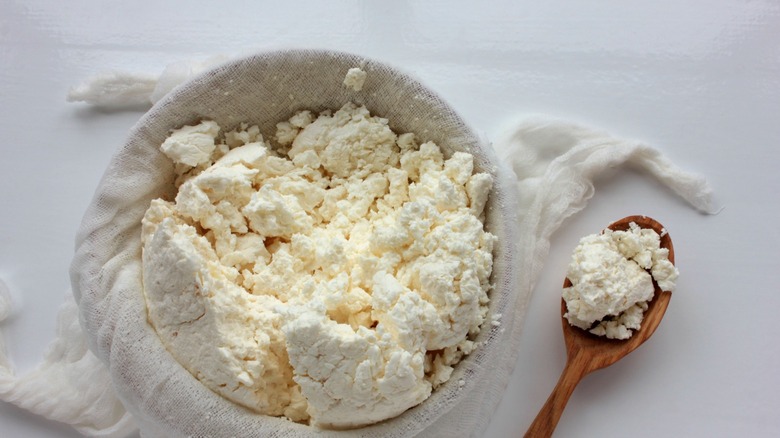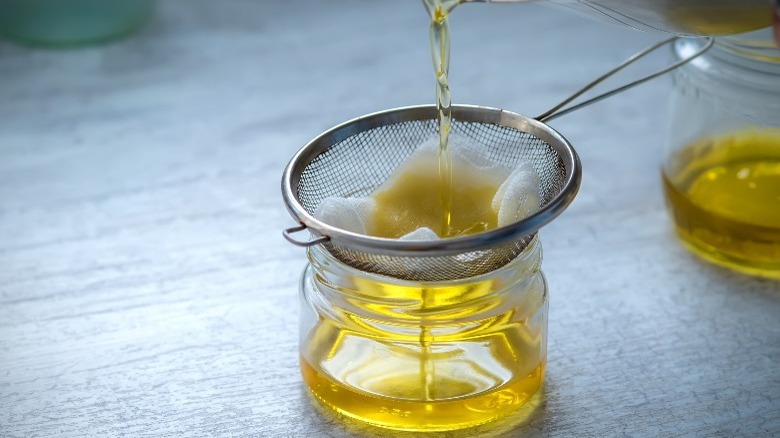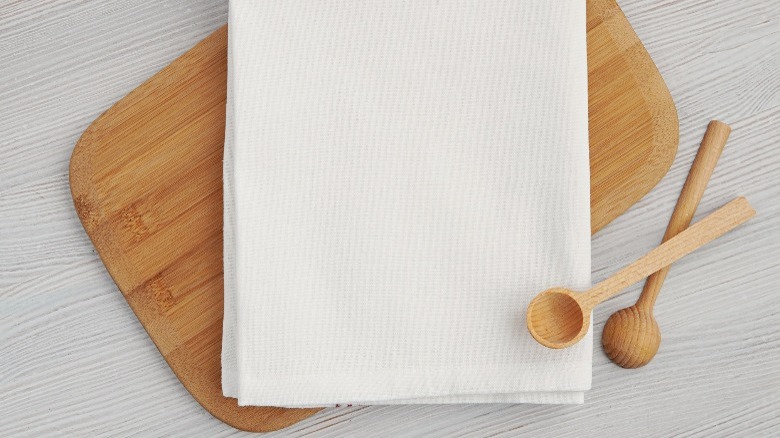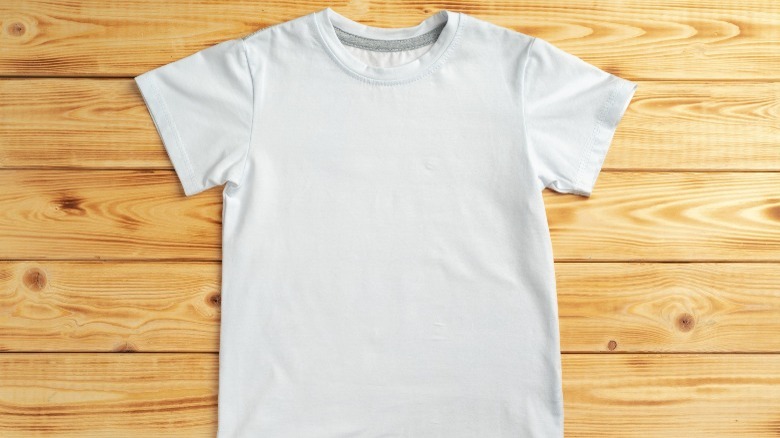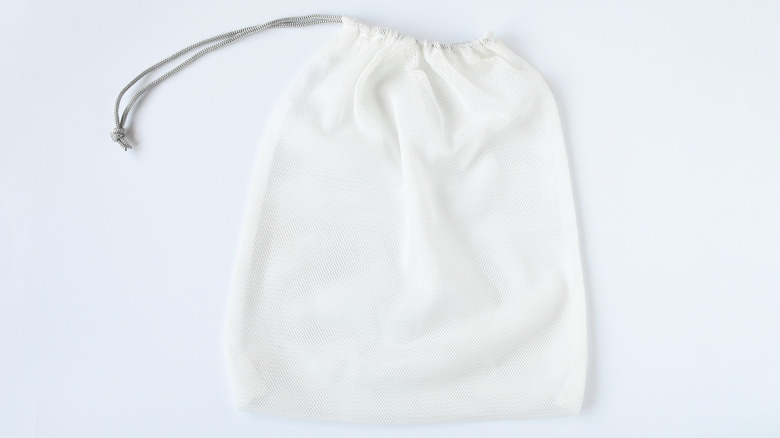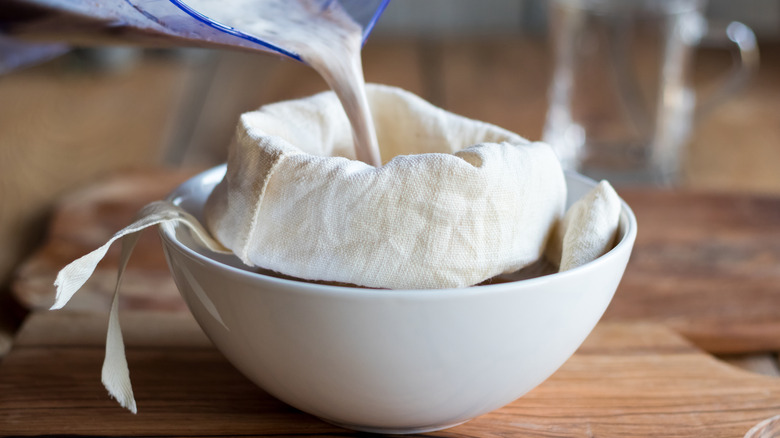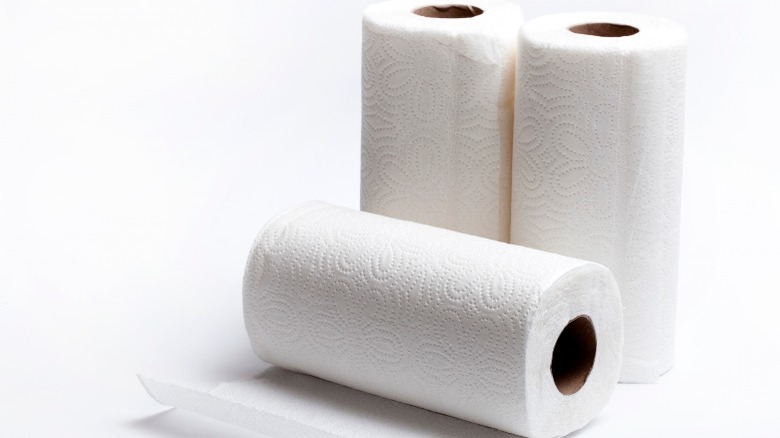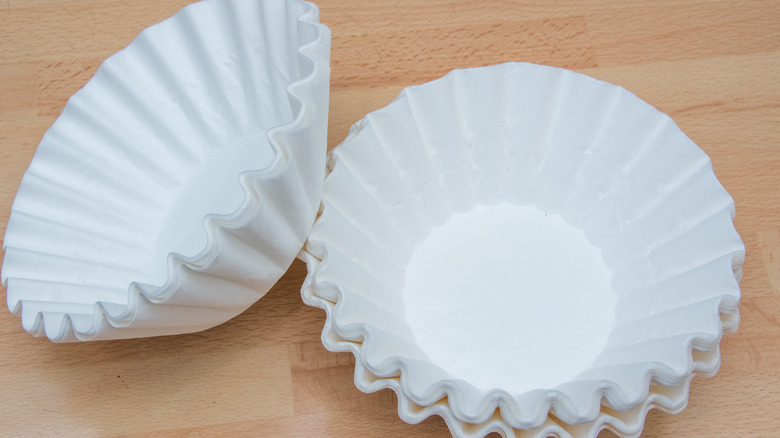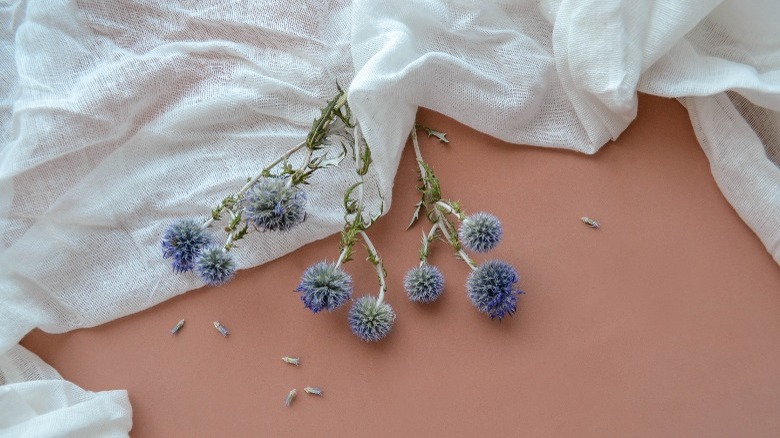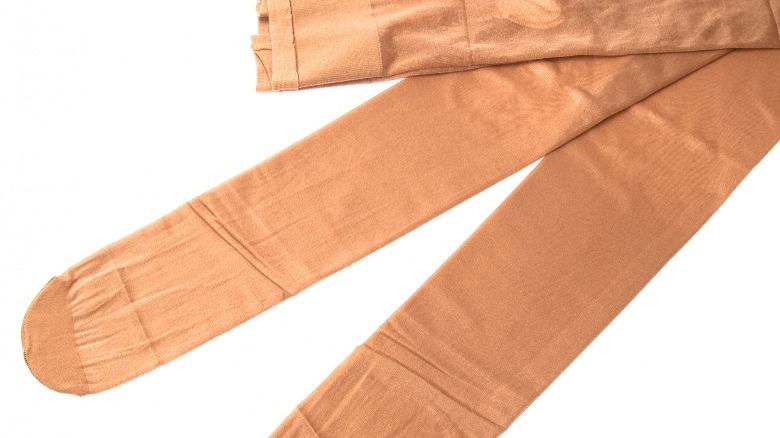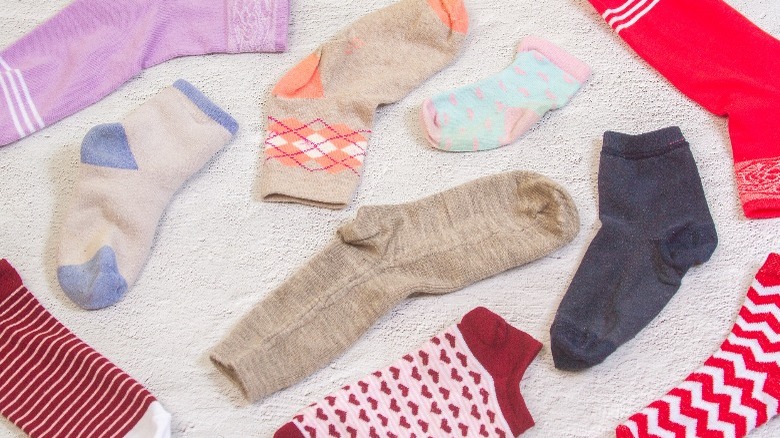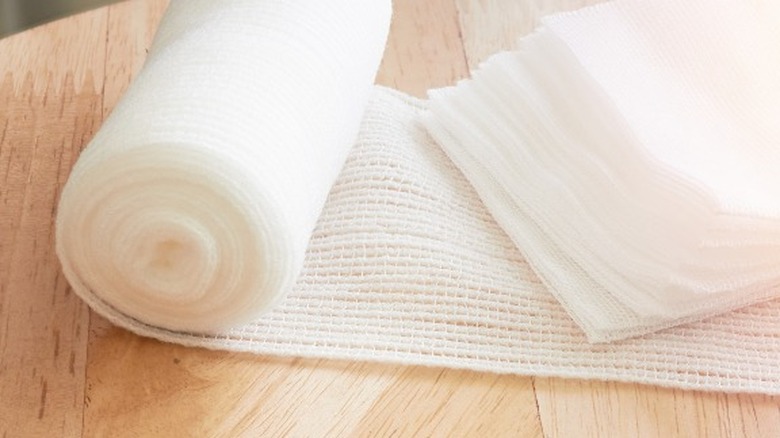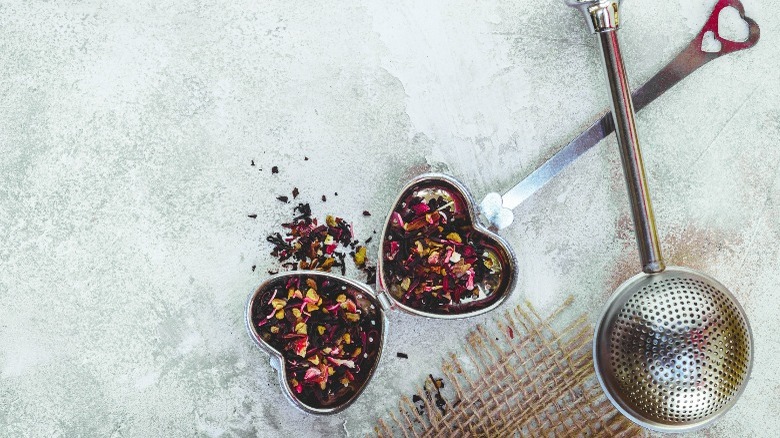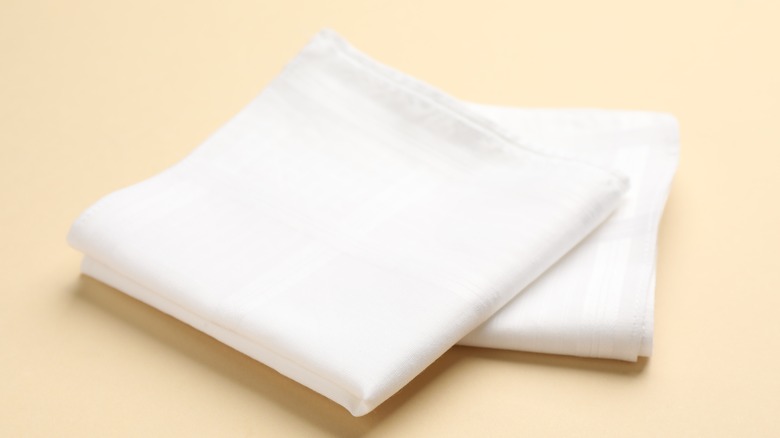13 Easy Alternatives For Cheesecloth
Whether you are making a batch of homemade cream cheese or your soup could use a delicate enhancement with the help of a spice sachet, cheesecloth comes in handy. The lightweight gauze-like fabric was initially designed to drain milk curds in cheese-making. Despite its name, cheesecloth is helpful beyond making cheese. Some people use it to strain blended nut milk, while others wrap their fruit cakes with it to retain moisture. But even if you've never made cheese, nut milk, or fruitcake, it's great to have on hand.
Cheesecloth is one of those multifunctional tools you love having around if cooking is your thing. For most of us, though, it's not necessarily something you add to the grocery shopping list every week. If you just noticed your stash of cheesecloth is fresh out, or you are following a recipe that calls for it, and you haven't found a need for it before, there are plenty of substitutes (kitchen-related or not) that you can use in its place. From straining hot stock to dusting pretty pastries, there is something hidden in your home that you can use in place of that handy gem of a cloth.
Fine-mesh sieve
Besides making cheese, cheesecloth is most widely known for its ability to strain liquids while removing the tiniest of particles. When you're making big batches of bacon and want to keep that precious grease for cooking (don't worry, we do the same), cheesecloth removes tiny bits from it like magic. It's also just the tool you need to remove curds from homemade yogurt or seeds from jams and jellies.
Not having the useful cloth on hand is no fun when you need a tool to strain fine specks from whatever you are making. That's where a fine-mesh sieve comes into play. Essentially a bowl-shaped, metal version of cheesecloth, this type of sieve is designed with a fine-mesh wire to remove very small particles from liquid. You can also use it to sift powder ingredients, leaving them light and airy for pastry-making purposes.
On the other hand, a colander is great for straining pasta or washing produce, but its larger holes won't catch tiny bits of food. Having both a sieve and a colander in your kitchen is necessary because they both serve different purposes.
Kitchen towel
When you have decided to take your chef skills up a notch and try your hand at cheese-making, you'll definitely want cheesecloth (or something similar) to get the job done. Luckily, there is a good chance you have a few dish towels that might work instead.
First, you should know that not all towels are created equal. Some dish towels are made from a material called terry cloth, which is designed with several tightly-woven loops, and these are great for absorbing water. Other types of kitchen towels, like tea towels and flour sack towels, are made from thin cotton or linen and, unlike terry cloth, won't produce lint (per Cotton Creations).
If you have thin tea towels or any lint-free dish towels, then you have just what you need to make a batch of homemade ricotta cheese or any other soft cheese. After heating your milk and adding vinegar or lemon juice, it will begin to curdle and form lumps. The tea towel will work perfectly to help drain the liquid and reach the desired consistency. Make sure to choose a white towel with no artificial dyes to avoid accidentally coloring your cheeses.
T-shirt
If you are wondering why anyone would think to grab a T-shirt for cooking purposes, we don't blame you. It might seem a little quirky to some, but believe it or not, using a clean tee works wonders in the place of cheesecloth. Similar to linen or cotton tea towels, cotton T-shirts are breathable enough to help strain curds when making cheese from scratch, but that's not all it does.
On a November 2021 episode of "Today," celebrity chef Martha Stewart revealed how anyone could use a T-shirt for their Thanksgiving turkey. Stewart shared her roast turkey recipe, which calls for covering the turkey with wine and butter-soaked cheesecloth. The cheesecloth prevents the turkey from getting brown too soon and ensures it stays moist while roasting.
If you don't have cheesecloth, Stewart says to use a clean T-shirt instead: "... soak that in the butter and white wine, and then you drape that over the bird." Beyond a great Thanksgiving dinner hack, you can use this nifty trick to impress guests in other recipes like roast chicken or quail, which tend to dry out because of their lean meat.
Fine-mesh bag
Fine-mesh bags make a fantastic substitute for cheesecloth in recipes where an infused liquid is needed to bring flavor to your dish. For example, if you're looking for a way to enjoy a yummy fish dinner that doesn't come with all the calories of breaded or fried versions, poaching can be a good option. Fish is an excellent source of high-quality protein and omega-3 fatty acids, and poaching or steaming it may preserve those precious fatty acids (via Healthline). While we are all about keeping things healthy, it's also crucial that what you eat tastes great.
To make your poached fish even more delicious, try using a flavorful liquid like some broth. Boost the flavor even further with the help of a quick makeshift sachet filled with fresh dill fronds, peppercorns, and citrusy lemon peels. Simply add a few select aromatics to a clean fine-mesh bag and throw it in the pot.
You can even get away with adding an impromptu sachet to a one-of-a-kind dinner like mussels escabeche, where the additional flavor is welcomed with the help of a bundle of herbs and spices. If you do use a fine-mesh bag as a sachet, make sure the bag is made with a heat-safe material like cotton. Some reusable bags are made with plastic which may melt over high heat.
Nut milk bag
Nut milk bags are often made from cheesecloth material, so they're a flawless replacement for cheesecloth in a pinch. If you have ever wanted to make a homemade batch of plant-based milk like almond milk, you only need two ingredients: water and raw almonds.
After soaking and blending both ingredients and then straining out the pulp, you'll have a delicious batch of nondairy milk before you. The nut milk bags keep the pulp from entering your milk, but don't throw that pulp away — set it aside and turn it into almond meal instead.
Using nut milk bags to make nut milk is a bit obvious, hence the name, but you'll find several other uses when you don't have cheesecloth on hand. For instance, use the bags to drain water when making cheese. Nut bags are also useful when you want to get the maximum amount of juice from a lemon: microwave your lemon first, cut it in half, place it in a nut milk bag and squeeze away. The microwave helps extract citrus juice, while the bag keeps the pulp and seeds from entering your dish.
Paper towels
There's a good chance you have a roll of paper towels somewhere in the house. In some instances, disposable paper towels are a good alternative to cheesecloth, but there are a few caveats.
Paper towels are not as durable as reusable cotton towels, so using them to squeeze liquids out in the straining process doesn't work as well. However, if you plan to use them to drain liquid with the help of gravity, paper towels are a solid substitute. Just be sure to account for the additional absorption of liquid that paper towels will pull from your dish.
Next time you decide to make a homemade broth or stock, consider using a paper towel-lined colander to strain out the vegetables, bones, or meat. Those paper towels will help create a crystal clear broth, but you will most definitely lose some of that precious liquid to your towels.
The bottom line is that paper towels are great when you can't find anything else for the job, mainly because they are highly accessible. Just be sure to use a high-quality brand for the job, as cheaper options may fall apart.
Coffee filters
Coffee filters are best known for filtering coffee grounds, but these inexpensive and widely available tools are excellent for many purposes. Of course, they strain liquids with ease, and because they are lint-free, they also wipe down windows without leaving pesky streaks. Many people love using them to prevent splatters, soak up bacon grease, and even skim fat. The point is there is plenty you can do with extra coffee filters.
When using this option in place of cheesecloth, you'll find it suitable for bundling up herbs to flavor stocks, soups, and sauces. Otherwise, coffee filters also do a fine job of straining. Just keep in mind that because the coffee filter material is woven so tightly, the straining process will take longer than when using a cheesecloth, so go for a slow, even pour to avoid spilling over.
One of our favorite ways to use coffee filters as a cheesecloth substitute is when making ghee, a keto-friendly substitute for butter. If you plan to make ghee at home, consider straining it through a coffee filter before storing it in a food-safe container.
Muslin blanket
Muslin is a woven cotton fabric that comes in several grades (per Britannica). The lightweight material is best known for making soft blankets to swaddle infants, but other kinds are constructed for cleaning purposes. Some types of muslin are similar to cheesecloth, and you can use them in the kitchen for more than a few purposes. It's perfect for making cheese because it strains beautifully, thanks to the fine stitching.
One of the most valuable ways to use muslin is for fruitcakes around the holidays. The dense cake, which somehow became a subject of a joke in recent decades, should be rich, flavorful, and — most importantly — moist. Unfortunately, mistakes are often made when making fruitcake, which causes it to taste like a dry heavy brick. One of the culprits of a dry fruitcake is neglecting to "feed" it. Feeding fruitcakes means poking holes, drizzling alcohol like brandy or cognac over the cake, then wrapping it with cheesecloth and plastic wrap. The process is all about retaining that essential moisture, and muslin fabric is a fantastic substitute when you don't have cheesecloth.
Beyond fruitcake, a clean muslin blanket will work when wrapping dry-aged steaks. Typically, dry-aged steaks are encased with cheesecloth, then placed in the refrigerator to age for a selected period of time before trimming and grilling (via MasterClass). The aging process produces a quality steak for which people pay big bucks.
Pantyhose
A set of pantyhose or tights are both inexpensive and widely accessible. You might even have a new pair in your dresser drawer right now. Besides covering your legs and making a fashion statement, those nylons can also make quite the impression in the kitchen.
If your recipe calls for dusting pastries with cocoa powder or powdered sugar, you'll be glad to know that cheesecloth isn't the only tool to get the job done. Instead, snip off the foot of your pantyhose, fill it with your powder of choice, and tap it over the pastry. Watch as minuscule particles fall over your pastry and make for a gorgeous finishing touch.
The same method works wonders for any cake-decorating enthusiast new to working with fondant. Instead of cocoa powder or powdered sugar, fill the pantyhose foot with cornstarch, then tie it off with a knot. Use it to powder surfaces while kneading in colors or rolling out the fondant.
Clean socks
If you thought the idea of using pantyhose as a cheesecloth replacement was weird, another funny foot apparel swap seems to do the trick — socks! Before you learn how cozy foot warmers might help in the kitchen, you should know a few things.
Like anything else you plan to cook with, you want to ensure you're working with freshly cleaned (or even brand new) socks. Plus, make sure you grab thin, airy socks, especially if you plan to use them for straining — and yes, they work great for that!
Cheesecloth isn't only used for cooking; many people also love it for cleaning (per Chicago Tribune). The lint-free construction makes cheesecloth an excellent fabric for wiping down windows, while the crepey texture is perfect for catching dust. If cheesecloth is typically your go-to cleaning rag, but you are fresh out, look for mismatched socks to get the job done. They are great for dusting around the house and cleaning surfaces.
Sterile medical gauze
Medical gauze and cheesecloth look almost identical, which means the material makes an excellent replacement in a pinch. Whether you have a first aid kit in your bathroom or car, chances are, it's complete with a sterile packaged roll. Gauze is thinner with a "looser weave" than cheesecloth, so if you plan to use it in the kitchen, you will likely have to layer it up a few times to reach the desired thickness.
Gauze will work best if layered to create a sachet d'epices, a small makeshift packet of herbs and spices bundled up in a cheesecloth, or in this case, medical gauze. Sachets save time when prepping herbs for a hot dish, like soup, stews, and stocks. They work to infuse the dish with fresh flavors and can be removed before serving, so guests won't have to fish out thick thyme stems and bay leaves during dinner.
Tea infuser
A bouquet garni is used the same way as a sachet to infuse dishes with flavor, but it's tied with twine rather than enclosed in cheesecloth. If your recipe calls for a sachet or bouquet garni, but you don't have gauze or string, there is another tool to help keep those herbs and spices together, and it's likely sitting in your tea box.
If you consider yourself a tea aficionado, then chances are you have a tea infuser with your collection of loose leaves. If you have never heard of one, it is a small metal meshed ball with a small chain or handle. The perforated infuser opens up so you can add your combination of tea leaves, then closes so you can dip it into hot water until it has steeped to your desired strength, just like a disposable tea bag.
If you have big plans to make hot cider or mulled wine in the cold months, your tea infuser will come in handy so you can avoid fishing out star anise and cloves. Otherwise, feel free to use it for broths or sauces next time a recipe calls for a sachet or bouquet.
Handkerchief
A handkerchief is a small square cloth typically used for blowing noses, so we get it if the idea of using one to cook with makes you a little squeamish. Not too many people keep one in their pocket for nose-wiping anymore, so it's more than likely the handkerchief you have at home is used for something else.
If you have a new or clean handkerchief, the thinner weave makes an ideal cheesecloth substitute when making cheese or straining liquids like broth. Also, if you can't find cheesecloth at the store, handkerchiefs make a suitable (and cheap) alternative.
Another bonus, of course, is that you can wash and rewash your handkerchief, making it an environmentally friendly swap. While shopping for a handkerchief, be sure to use one that is free from dyes to avoid color running into your foods. A simple white one is a safer bet for kitchen use.
